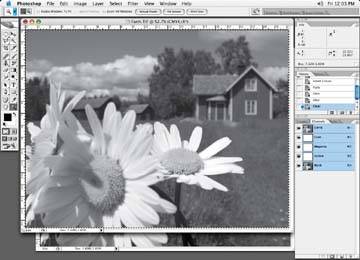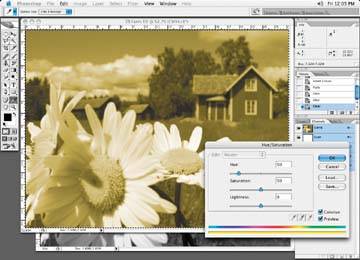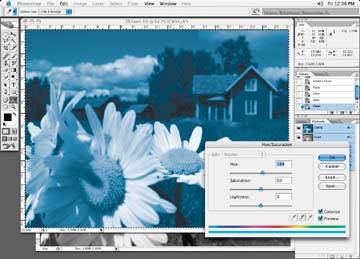You should get into the habit of checking your color settings though prior to any conversion to another color mode. I typically use the US swop coated, but you may have another setting you prefer; just make sure it is loaded prior to changing your file.
Creating Fake Duotones
You can also change overall color to create a "fake" duotone look in CMYK with the Image » Adjustments » Hue and Saturation command.
First, create a copy of your image and grayscale it. You don't have to change the image to a grayscale image to colorize it with the Hue and Saturation, but it seems to produce a better result. I have noticed that the image can lose detail in some areas when using a full-color image.
Make a selection of the grayscale image and paste it into the black channel of your CMYK image (Figure 5-53), and then delete all the other colors: cyan, magenta, and yellow.
By all means, try a full-color image first, if you're looking to save time.
Figure 5-53. Paste the grayscale image into the black channel; delete all other channel information

Next, select Image » Adjustments » Hue and Saturation. In the Hue and Saturation dialog box, starting with all sliders in the center positions, move the Hue slider around until you get the color you want, as in Figure 5-54.
Figure 5-54. Move the Hue slider and adjust until the desired color is achieved

In this case, I've chosen a cold blue look for our farmhouse (Figure 5-55).
Figure 5-55. The final image

With this method of creating colored images, changing the image to different colors may knock out some of the channels to nothing, depending on the color you make it. Losing information in one particular channel may not be an issue for you, but just make sure you are aware of it.
If you desire information in all channels, you may have to go into another correction mode, like channel mix, to add information back into the file after a Hue and Saturation color change. Or change your image from its current CMYK mode to RGB, and then back to CMYK. This process will put information back into all channels, but at the possible expense of a slight color shift.
Printing Images with Spot Colors in Them
If you own a desktop inkjet printer, unfortunately you will not be able to see the results of your spot colors correctly. Most ink jets cannot simulate spot colors accurately and are limited to the inks in the printer. To recreate the spot colors correctly, you'll have to have your files output on a high-end proofing device or get a film-based proof made to create a final proof with the spot colors in it.
One other thing to keep in mind is that printing an image with a spot color channel to a composite color printer will print the spot color at an opacity indicated by the solidity setting. So be careful of this.